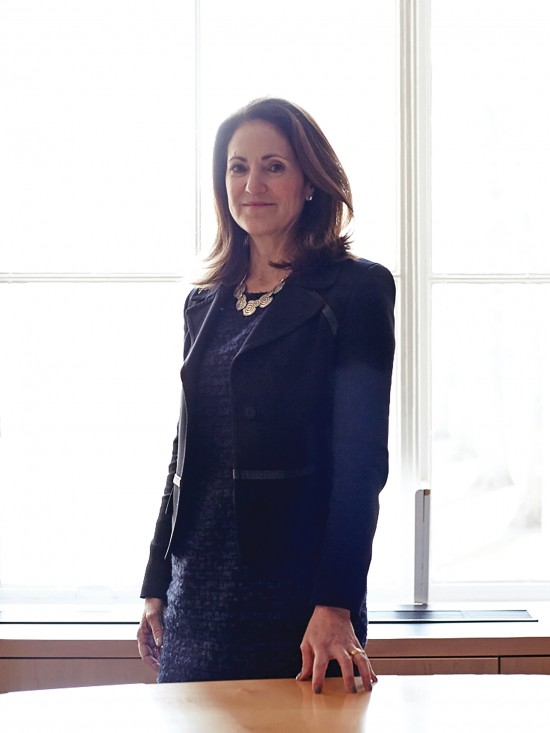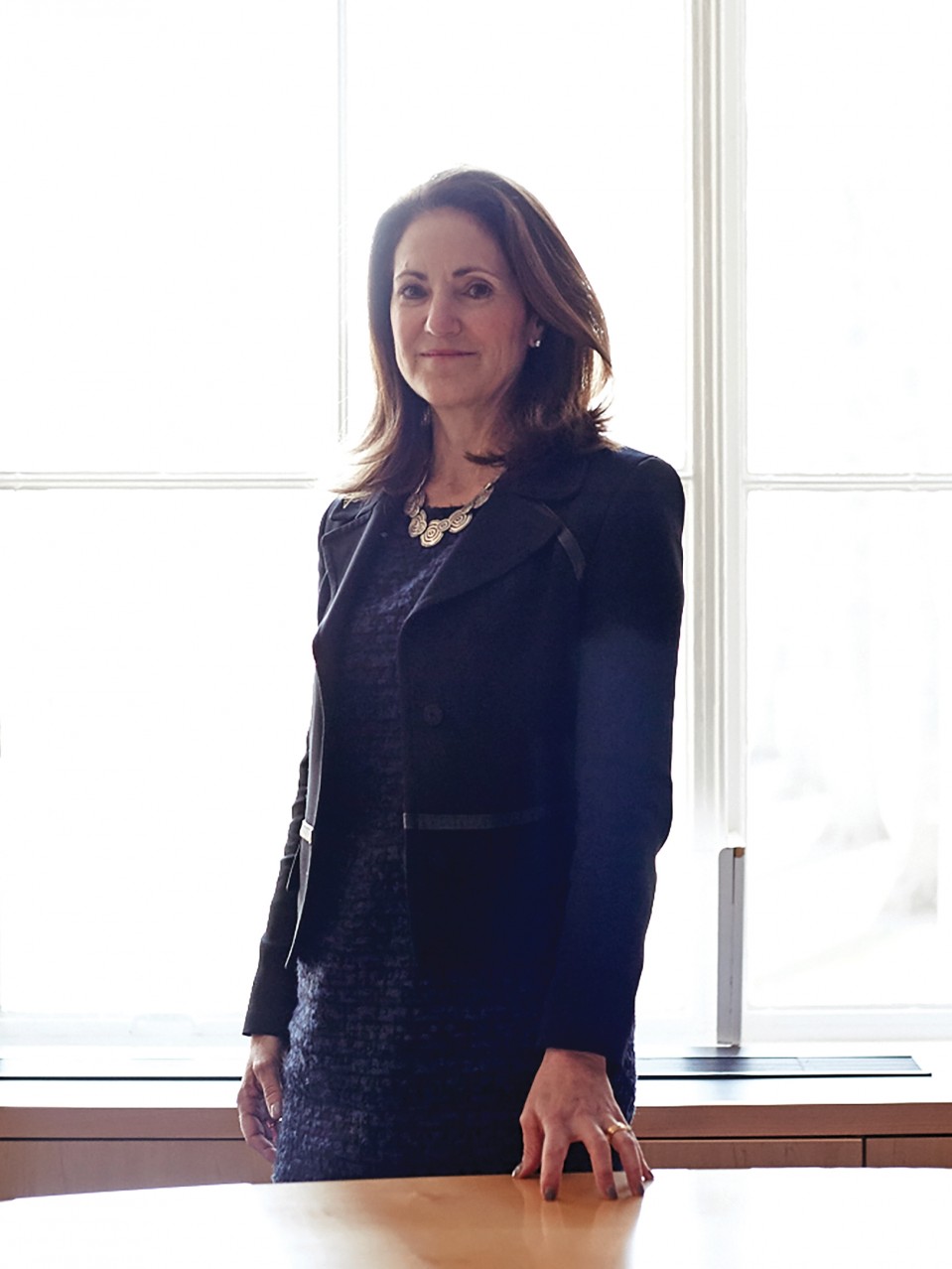The Toughest Job on Campus
MIT’s chancellor, Cynthia Barnhart, SM ’85, PhD ’88, tackles difficult issues from an engineer’s perspective.



Cynthia Barnhart had been chancellor of MIT for all of two days in February of 2014 when she found herself in a meeting with President Rafael Reif and other senior MIT officers, discussing a disturbing article that had just run in the Tech. In the piece, an anonymous MIT alumna had explained in agonizing detail how she had been raped by a man in her research group.
The article made an issue already on her agenda seem all the more urgent. Reif gave Barnhart a charge: she needed to make addressing sexual assault on campus a central priority.
She didn’t flinch. “I am a problem solver,” says Barnhart, who is also the Ford Foundation Professor of Engineering in the Department of Civil and Environmental Engineering.
In her first two years as MIT’s top administrator for student affairs, Barnhart has grappled not only with sexual assault on campus but with substance abuse and suicide as well. And she’s tackled these thorny problems with an engineer’s mind-set. “When I hear about an issue that needs to be addressed, I approach it very much like I approach my research,” she says. “It’s always been very, very data-intensive.”
Barnhart first came to the Institute in 1984 for the master’s program in transportation. She specialized in transportation and operations for her MIT doctoral research and, after earning her PhD in civil and environmental engineering, taught at Georgia Tech for four years. In 1992, she joined MIT’s faculty, continuing her work developing mathematical models and complex algorithms to help airlines optimize their flight schedules as well as their aircraft fleet and crew operations. Many models she developed have become gold standards in the industry. Her research also includes measuring the effect of weather disruptions and flight delays. (One finding frequent fliers can relate to: every hour of flight delay translates into a delay of an hour and 40 minutes for passengers.)
At MIT, Barnhart earned a reputation as an exceptional mentor. “She loves to talk to people, especially students, to understand what is important to them,” says Amedeo Odoni, a professor emeritus of aeronautics and astronautics who served as her senior faculty mentor when she joined the faculty. “There is always a queue of students who want to work with her.”
When she started to look at the issue of sexual assault on campus, Barnhart’s first impulse was to gather data, so she met with students that spring to get their perspective. A group of 15 victims made the biggest impression. “When they spoke about their experiences, their voices still cracked, or their hands were still shaking,” she remembers. Yet only one had reported the experience to campus authorities. “Many of them said they didn’t think it was that serious,” she says. “There was such a disconnect. That’s when I understood just how complicated it was.”
To get at that complexity, Barnhart commissioned a comprehensive, campus-wide survey on sexual misconduct, declaring from the outset that MIT would release the full results publicly, no matter what. It was something no other major university had done. “One of the things that I heard from students was that they wanted transparency,” she says. “I said if this is truly a problem, we need everyone to be talking about it.”
While a recent sexual assault survey conducted on 27 campuses got only a 19 percent response rate, 35 percent of MIT students took part in the Institute’s Community Attitudes on Sexual Assault study. The results showed that 17 percent of female undergraduates who responded to the survey had been sexually assaulted, comparable to the national rate. But only 5 percent of all students who’d had an unwanted sexual experience at MIT had reported it, compared with 5 to 28 percent in the 27-college survey (depending on the type of offense). Students were surprised. “They thought MIT was different, and better,” Barnhart says. “That this is a problem here as everywhere else speaks volumes.”
The survey revealed a great deal of confusion about what sexual assault was and when it was a big enough deal to report. So Barnhart focused on increasing education and lowering barriers to reporting. She expanded the Violence Prevention & Response (VPR) program from three to seven people, created a Title IX office with a staff of three (two of them new), and convened a commission to revamp disciplinary procedures. Today, sexual assault cases are expedited, going before a smaller, specially trained panel of three instead of the general disciplinary board of seven, with the victim and accused remaining in separate rooms. (Counselors also help students file charges with police if they choose.)
In addition to focusing on the response to sexual assault, Barnhart took steps to decrease its incidence in the first place. She worked with the VPR program and a student-led Title IX working group to develop and implement an MIT version of the national “It’s On Us” campaign, which aims to help students understand and stop sexual assault. And when the Interfraternity Council came to her with its Party Safe Plus plan, which would include education on bystander intervention in situations of possible assault, she encouraged it. “Other administrators may have said this is a good idea but it’s too important for [students] to be involved with and screw up,” says Haldun Anil ’15, then president of the Interfraternity Council. But Barnhart, he says, advised rather than supervised the process, allowing the fraternity community to generate and implement the ideas.
In the year after the survey’s results were released, in October 2014, the Title IX office saw a 29 percent increase in reported cases of sexual assault and gender-based discrimination (from 69 to 89), and the VPR reported a 53 percent increase (from 75 to 115) in its overall caseload, not all of which involved sexual assault. Nine sexual misconduct cases went before the Committee on Discipline in 2014-15, up from four the previous academic year. This may not sound like good news, but Barnhart expected reporting to go up with greater awareness of the issue—and she sees the increase in Title IX and VPR caseloads as a step in the right direction.
“We think more reporting is a positive sign and an indication that our enhanced education and outreach efforts are having the intended effects,” she says. “More members of our community are empowered with information about what constitutes sexual misconduct and where to go for help.” She hopes the community’s efforts are also reducing the rate of sexual assault. (Determining whether the increase in reported cases reflects a higher percentage of people reporting incidents or an actual increase in sexual assault is difficult, but the issue will be investigated.)
As the sexual assault education campaign got under way, another serious issue was also demanding Barnhart’s attention: a series of suicides in 2014 and the spring of 2015. The deaths caused the MIT community to look inward at the overall mental health of students on campus.
It’s no secret that the school’s intense environment puts incredible pressure on students—and can affect their mental health in many ways. In order to better understand the issue, Barnhart once again turned to data, partnering with the Jed and Clinton foundations, which recommended taking part in the University of Michigan’s Healthy Minds survey on students’ feelings about mental health. That survey has been conducted at over 100 campuses nationwide.
MIT’s survey results, released in September 2015 with 28 percent of students responding, documented an exceptionally high level of stress on campus. A full 77 percent of undergraduate respondents agreed or strongly agreed with the statement that “the academic environment has a negative impact on students’ mental and emotional well-being”—far above the national average of 36 percent. Yet MIT students are not much more apt to seek help for mental and emotional problems than they are for sexual assault. Half of all undergrad respondents who said they needed help resisted getting it.
In response to the data, MIT increased counseling staff, adding two full-time psychologists to the Mental Health and Counseling Service (MH&C) and two additional deans to Student Support Services (S3), which provides academic and personal support and referrals to mental health services through the Office of Undergraduate Advising and Academic Programming. “To tackle these challenges, we need comprehensive strategies that rely on a combination of immediate and long-term action steps,” Barnhart says. “At MIT we are doing that first and foremost by expanding access to critical services.”
To encourage students to get the help they need, Student Support Services doubled walk-in hours, pushing them back later in the day, and MH&C added online scheduling for appointments. It also started offering informal, walk-in visits in Building 8, to avoid the stigma associated with a formal appointment. “They don’t have to walk over to Medical,” Barnhart says. “All they have to do is walk down the hall and put an X in the time slot and then show up at that time to chat.” The Division of Student Life and MIT Medical also recruited and trained 32 additional confidential one-on-one student advisors to help connect students with mental health services.
To help reduce stress and improve students’ quality of life and mental health over the long term, Barnhart and MIT Medical launched the campus-wide MindHandHeart initiative, which taps into the MIT community’s problem-solving skills. Working groups of faculty, students, and staff are charged with focusing on key areas: mental health and substance abuse, connectedness, academic performance, help-seeking behavior, life skills, and wellness.
In September, MindHandHeart kicked off the “Don’t Struggle Alone—It’s OK to Ask for Help” campaign, designed to reduce students’ reluctance to seek help when they need it. And seeing people wearing “Tell Me About Your Day” bracelets, the brainchild of Izzy Lloyd ’18, also reminds students that others on campus are there to support them. The MindHandHeart Innovation Fund aims to solicit more such ideas to reduce stress and feelings of isolation and promote wellness, with grants of up to $10,000 to implement them. The first batch of winners, announced in November, includes a “Random Acts of Kindness” week, a winter gardening program, a puppy lab project that brings therapy dogs to campus for stress-relieving study breaks, and a series of “slow looking” art workshops at the MIT List Center, which invite members of the community to engage deeply with a work of art through close observation and conversation. The fund will also support a wellness and mindfulness curriculum for students, including a seminar program for first-year students.
Meanwhile, Barnhart is supporting an effort by the Department of Electrical Engineering and Computer Science to study student workload. A professor created a tool that incorporates data from a weekly survey of Course 6 students and lets instructors enter major assignments and exams, then check for conflicts with other classes. Its use in the fall led one professor to cancel a p-set and another to postpone a take-home midterm.
“Addressing these complex issues takes time,” Barnhart says, “so it’s too soon to fully measure the impact our new efforts are having.” But now armed with baseline data, she will administer a new sexual assault survey in the next academic year. In the meantime, the MindHandHeart steering committee is establishing metrics to track mental health and the risk factors that lead to behaviors like substance abuse and suicide. The committee will post frequent reports, and Barnhart will, as usual, be keeping a very close eye on the data.